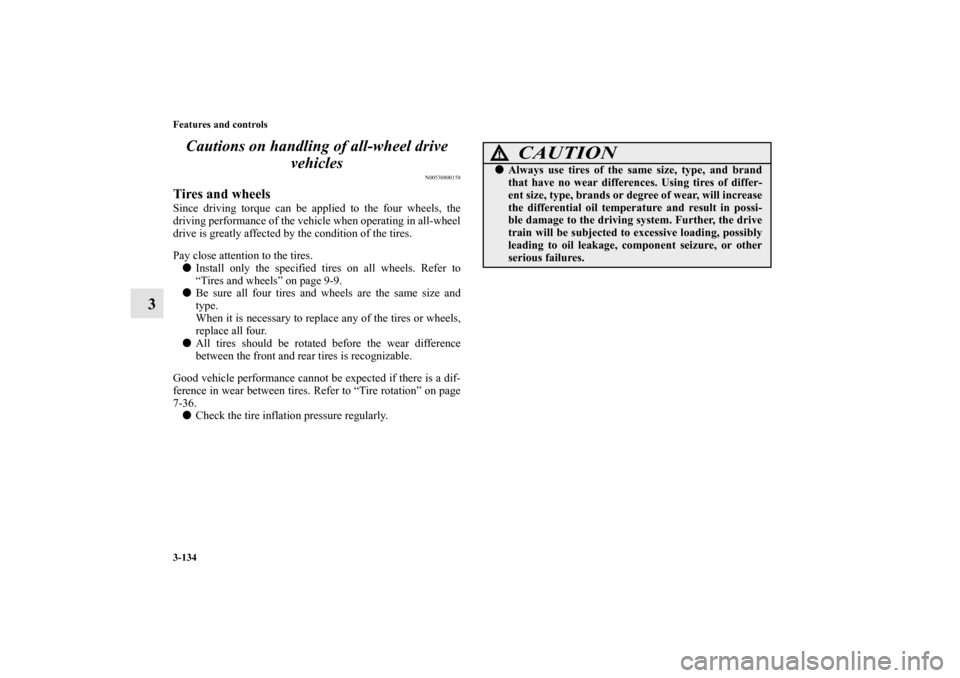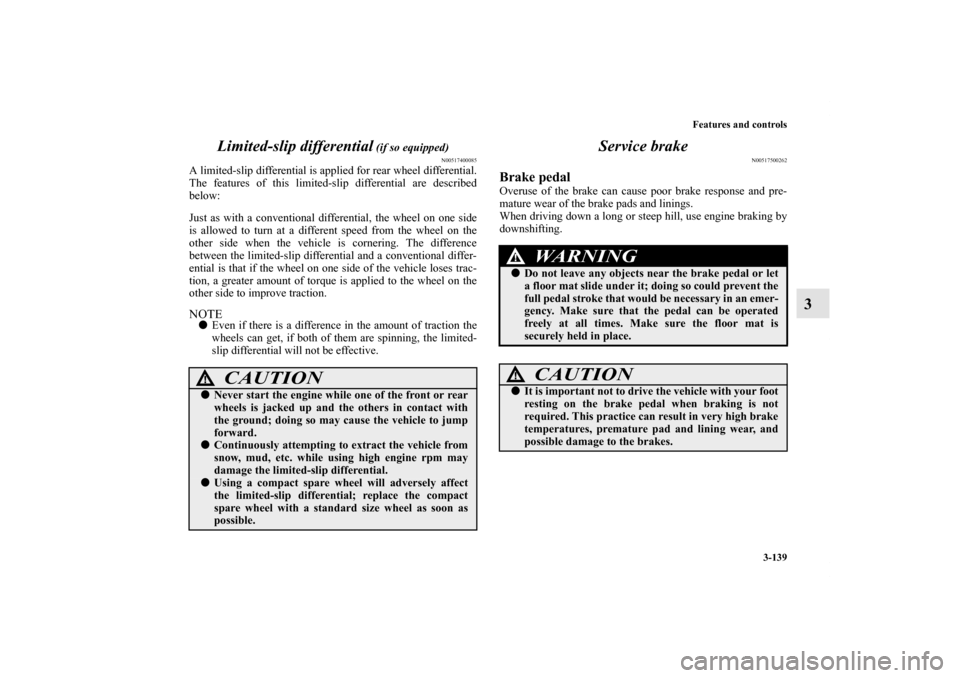Page 227 of 706

3-134 Features and controls
3Cautions on handling of all-wheel drive
vehicles
N00530800158
Tires and wheelsSince driving torque can be applied to the four wheels, the
driving performance of the vehicle when operating in all-wheel
drive is greatly affected by the condition of the tires.
Pay close attention to the tires.
�Install only the specified tires on all wheels. Refer to
“Tires and wheels” on page 9-9.
�Be sure all four tires and wheels are the same size and
type.
When it is necessary to replace any of the tires or wheels,
replace all four.
�All tires should be rotated before the wear difference
between the front and rear tires is recognizable.
Good vehicle performance cannot be expected if there is a dif-
ference in wear between tires. Refer to “Tire rotation” on page
7-36.
�Check the tire inflation pressure regularly.
CAUTION
!�Always use tires of the same size, type, and brand
that have no wear differences. Using tires of differ-
ent size, type, brands or degree of wear, will increase
the differential oil temperature and result in possi-
ble damage to the driving system. Further, the drive
train will be subjected to excessive loading, possibly
leading to oil leakage, component seizure, or other
serious failures.
BK0151000US.book 134 ページ 2012年3月29日 木曜日 午後6時8分
Page 232 of 706

Features and controls
3-139
3 Limited-slip differential
(if so equipped)
N00517400085
A limited-slip differential is applied for rear wheel differential.
The features of this limited-slip differential are described
below:
Just as with a conventional differential, the wheel on one side
is allowed to turn at a different speed from the wheel on the
other side when the vehicle is cornering. The difference
between the limited-slip differential and a conventional differ-
ential is that if the wheel on one side of the vehicle loses trac-
tion, a greater amount of torque is applied to the wheel on the
other side to improve traction.NOTE�Even if there is a difference in the amount of traction the
wheels can get, if both of them are spinning, the limited-
slip differential will not be effective.
Service brake
N00517500262
Brake pedalOveruse of the brake can cause poor brake response and pre-
mature wear of the brake pads and linings.
When driving down a long or steep hill, use engine braking by
downshifting.
CAUTION
!�Never start the engine while one of the front or rear
wheels is jacked up and the others in contact with
the ground; doing so may cause the vehicle to jump
forward.�Continuously attempting to extract the vehicle from
snow, mud, etc. while using high engine rpm may
damage the limited-slip differential.�Using a compact spare wheel will adversely affect
the limited-slip differential; replace the compact
spare wheel with a standard size wheel as soon as
possible.
WA R N I N G
!�Do not leave any objects near the brake pedal or let
a floor mat slide under it; doing so could prevent the
full pedal stroke that would be necessary in an emer-
gency. Make sure that the pedal can be operated
freely at all times. Make sure the floor mat is
securely held in place.
CAUTION
!�It is important not to drive the vehicle with your foot
resting on the brake pedal when braking is not
required. This practice can result in very high brake
temperatures, premature pad and lining wear, and
possible damage to the brakes.
BK0151000US.book 139 ページ 2012年3月29日 木曜日 午後6時8分
Page 574 of 706
For emergencies
6-17
6
8. Lower the vehicle slowly by rotating the wheel nut
wrench counterclockwise until the tire touches the
ground.9. Tighten the nuts in the order shown in the illustration until
each nut has been tightened to the torque listed here.
65 to 80 ft-lb (88 to 108 N•m)
10. Lower the jack all the way and remove it.
CAUTION
!�Never use your foot or a pipe extension to apply
added force to the wheel nut wrench when tighten-
ing the wheel nuts. If you do so, you can over-tighten
the wheel nuts and damage the wheel, wheel nuts
and hub bolts.
BK0151000US.book 17 ページ 2012年3月29日 木曜日 午後6時8分